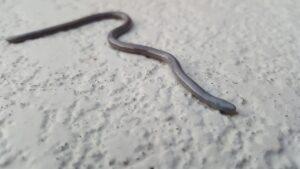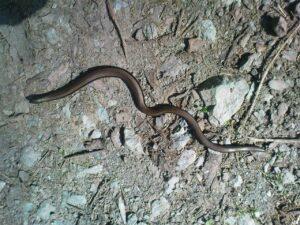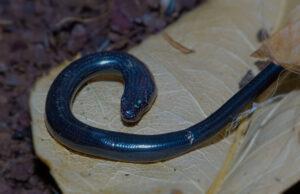Did you know that hidden beneath the surface of the Earth, there exists a fascinating creature that remains largely unnoticed? Meet the Brahminy blind snake (Indotyphlops braminus), a remarkable reptile with a lifestyle shrouded in mystery.
Despite its small size and subterranean habits, this serpent holds a treasure of fascinating traits and behaviors waiting to be uncovered.
In this article, we will explore the habitat, characteristics, behavior, interesting facts, classification, and much more about the Brahminy blind snake. From its hidden existence to its remarkable adaptations, we delve into the lesser-known aspects of this captivating creature.
Table of Contents
Physical Characteristics
The Brahminy blind snake may be small but has some interesting physical features. Let’s take a closer look at its characteristics:
The Brahminy blind snake, also known as the flowerpot snake, may not catch your eye at first glance due to its small size and lack of visual senses. Nevertheless, its unique physical characteristics make it a fascinating creature to study and appreciate.
| Physical Characteristics | Description |
|---|---|
| Size | Typically measures around 6 to 8 inches long. |
| Body Shape | Slender and cylindrical in shape |
| Skin Texture | Smooth and shiny |
| Skin Color | Light brown, Gray, or sometimes reddish or pinkish |
| Eyes | Small, vestigial eyes covered by scales and non-functional |
| Head | Small, rounded head with a narrow snout |
| Mouth | Tiny mouth without teeth |
| Feeding Method | Uses a specialized mechanism to consume ant and termite eggs and larvae called "sticking out of the tongue." |
| Senses | Relies on senses other than sight for navigation and finding prey |
Distribution and Habitat
Let’s explore the habitat and where you can find these intriguing reptiles:
Distribution
The Brahminy blind snake is native to Southeast Asia, including countries such as India, Sri Lanka, Myanmar, Thailand, Vietnam, and the Philippines. However, due to human activities and accidental transportation, they have been introduced to many other parts of the world, including Africa, the Americas, Australia, and the Pacific Islands.
Habitat
These snakes have adapted to various habitats, ranging from forests to grasslands and even urban areas. However, they are primarily associated with underground environments. Brahminy blind snakes are burrowers, spending most of their lives hidden beneath the soil’s surface.
Their subterranean lifestyle allows them to thrive in various soil types, including sandy, loamy, and clay soils. They can be found in gardens, agricultural fields, and other areas with loose soil where they can easily maneuver and search for their preferred food source.
Their diet influences their habitat, primarily eating ants, termite eggs, and larvae. These food sources are abundant in the soil, making the underground environment an ideal hunting ground for these small serpents.

Behavior and Lifestyle
We already know about the burrowing and feeding habits of Brahminy blind snakes. Let us explore some more interesting details about the lifestyle of this serpent:
1. Nocturnal Activity
These snakes are primarily active during the night, exhibiting nocturnal behavior. The cover of darkness protects them and reduces their exposure to potential threats.
They emerge from their burrows under the cover of night to forage for food and engage in other essential activities.
2. Elongated Body and Flexible Movement:
The slender body of this baby snake, along with its reduced eyes and tiny scales, enables it to move smoothly through narrow underground tunnels. It can contort its body and navigate through tight spaces, utilizing its burrowing skills to explore its habitat.
3. Reproduction
Brahminy blind snakes reproduce through parthenogenesis, where females can produce offspring without mating with males. This asexual mode of reproduction allows a single female snake to give birth to genetically identical offspring.
This reproductive strategy contributes to this species’ successful colonization and rapid population growth in various regions.
4. Predator Avoidance
To avoid predators and minimize their chances of detection, Brahminy blind snakes rely on their subterranean lifestyle and camouflage. By remaining hidden beneath the soil and blending in with their surroundings, they reduce the risk of being spotted by potential predators.
Taxonomy and Classification
Understanding the taxonomic classification helps us categorize and study this reptile about other organisms in the natural world.
Although it’s a bit scientific and less of use for commoners, here is an easy-to-understand overview that will surely increase your knowledge about the Brahminy blind snake.
| Taxonomy | Type | Description |
|---|---|---|
| Kingdom | Animals | Multicellular organisms that consume other organisms and lack cell walls. |
| Phylum | Chordates | Animals with a notochord (a flexible rod-like structure), dorsal nerve cord, pharyngeal slits, and post-anal tail. |
| Class | Reptiles | Cold-blooded vertebrates with scaly skin, lungs, and shelled eggs. |
| Order | Squamates | Reptiles with overlapping scales, including snakes and lizards. |
| Family | Blind Snakes | Small, non-venomous snakes with reduced eyes and burrowing lifestyle. |
| Genus | Indotyphlops | Genus containing blind snakes found in Asia. |
| Species | Brahminy blind snake (Indotyphlops braminus) | A specific species associated with India. |
Interactions with Humans
Let’s explore how these unique snakes intersect with human activities and environments:
1. Aggressive Species
The Brahminy blind snake has been unintentionally introduced to many parts of the world through human activities, such as transporting plants and soil. As a result, it has become an aggressive species in some regions, particularly in tropical and subtropical areas.
2. Garden Pests
While these snakes primarily feed on ants and larvae, they can unintentionally disrupt gardens or agricultural areas by consuming beneficial insects, such as pollinators or pest predators. However, their impact on agricultural ecosystems is generally considered minimal.
3. Accidental Encounters
Due to their subterranean lifestyle, these snakes are rarely encountered by humans. However, occasional accidental encounters may occur when people are gardening, excavating soil, or during heavy rains when the snakes may surface. These encounters are typically harmless.
4. Research and Education
The snakes serve as subjects of scientific research, contributing to our understanding of their biology, ecology, and evolutionary adaptations. Their ability to reproduce through parthenogenesis is particularly interesting to scientists studying reptiles’ reproductive strategies.
5. Conservation Considerations
While Brahminy blind snakes are not endangered, their widespread distribution and potential impact as aggressive species raise conservation concerns in certain regions. Monitoring their population dynamics and studying their ecological roles help inform conservation strategies for preserving native ecosystems.

Mythology and Interesting Facts
Here are some fascinating facts and snippets of mythology related to the Brahminy blind snake.
1. Mythological Connections
In Hindu mythology, the snake is associated with the Nagas, a mythical race of serpent-like beings. Nagas are revered as divine creatures and are often depicted as guardians of treasures, water bodies, or powerful deities. The snake’s presence and association with the Brahmins have also contributed to its mythical significance.
2. Tiny Snake, Widespread Distribution
It is one of the world’s smallest snake species, with adults typically measuring around 6 to 8 inches long. Despite its small size, it boasts an extensive distribution in regions ranging from Southeast Asia to various parts of Africa, the Americas, Australia, and the Pacific Islands.
3. Misidentification as Earthworms
Due to their small size and worm-like appearance, Brahminy blind snakes are occasionally mistaken for earthworms. This misidentification can occur when they accidentally surface after heavy rains, leading people to confuse them with common garden worms.
4. Lack of Defensive Strategies
Unlike many other snakes, these snakes lack poison and physical defensive mechanisms like fangs or strong jaws. Instead, they rely on their subterranean lifestyle, cryptic coloration, and the ability to burrow quickly to avoid predation.
5. Cryptobiotic Survival
When faced with harsh environmental conditions, such as extreme temperatures or lack of food, Brahminy blind snakes can enter a state of cryptobiosis. During this dormant state, their metabolic rate slows, allowing them to survive without food or water until conditions improve.
6. Influence on Soil Ecology
As burrowing organisms, these snakes play a role in soil turnover and nutrient cycling. Their activities can affect soil structure, aeration, and the distribution of organic matter, contributing to the overall health and functioning of soil ecosystems.
7. Indicator Species
They are considered indicator species, meaning their presence or absence can provide insights into an area’s health and ecological conditions. Monitoring their population dynamics and studying their interactions with their environment can help assess ecosystems’ overall biodiversity and functioning.
Similar species to Brahminy blind snake
The Brahminy blind snake (Indotyphlops braminus) belongs to the family Typhlopidae, which includes several other species of blind snakes. Let’s discover some more identical species like this.
| Species | Scientific Name | Distribution | Characteristics |
|---|---|---|---|
| Florida Blind Snake | Indotyphlops braminus | Southeastern United States (particularly Florida) | Small size, Subterranean lifestyle, Reduced eyes, Reproduces through parthenogenesis |
| Western Blind Snake | Leptotyphlops humilis | North America | Small size, Subterranean lifestyle, Reduced eyes, Smooth scales |
| Texas Blind Snake | Leptotyphlops dulcis | North and Central America | Small size, Subterranean lifestyle, Reduced eyes, Belongs to the family Leptotyphlopidae |
| Mexican Blind Snake | Leptotyphlops mexicanus | Mexico, Central America | Small size, Subterranean lifestyle, Reduced eyes, Belongs to the family Leptotyphlopidae |
Conservation Efforts
While the snake is not currently considered endangered, several conservation initiatives and strategies can aim to protect its habitats. Here are some key conservation efforts that you can take regarding Brahminy blind snake:
1. Habitat Protection
Conservation organizations and government agencies can work towards preserving the natural habitats where this snake is found. This includes protecting forests, grasslands, wetlands, and other habitats that provide suitable conditions for the snake’s survival.
By safeguarding these habitats, the region’s overall biodiversity and ecological balance can be maintained.
2. Invasive Species Management
In regions where this snake has become an invasive species, efforts can be made to manage its populations and mitigate potential impacts on native flora and fauna.
This may involve monitoring and controlling the spread of the species, implementing quarantine measures, and raising awareness among communities about the potential ecological risks associated with invasive species.
3. Research and Monitoring
Research initiatives focused on the snake contribute to our understanding of its population dynamics, habitat requirements, and interactions with other species.
By monitoring population trends and studying the species’ ecology, conservationists can assess the effectiveness of conservation measures and adapt strategies accordingly.
4. Education and Awareness
Raising public awareness about the importance of reptiles and their role in ecosystems is crucial for their conservation. Educational programs, community outreach, and public campaigns help promote understanding, appreciation, and conservation.
These efforts also emphasize conserving their habitats and promoting sustainable practices to ensure long-term survival.
5. Collaboration and Partnerships
Conservation efforts often involve collaboration between government agencies, conservation organizations, researchers, local communities, and other stakeholders.
These groups can pool resources, share knowledge, and implement effective conservation strategies to protect the snake and its habitats by working together.

Frequently Asked Questions (FAQs)
1. What is the size of the Brahminy blind snake?
It is one of the world’s smallest snakes, typically measuring around 15-20 centimeters (6-8 inches) in length.
2. Can the Brahminy blind snake see?
It has reduced eyes that are not functional, and the snake primarily relies on other senses for survival.
3. How does the Brahminy blind snake reproduce?
It reproduces through parthenogenesis, where females can produce offspring without mating with a male.
4. What does the Brahminy blind snake eat?
The snake feeds primarily on ants and termites, making it insectivorous.
5. Where is the Brahminy blind snake found?
The snake is widely distributed and can be found in Southeast Asia, Africa, the Americas, and Australia.
6. Is the Brahminy blind snake venomous?
No, it is non-venomous and poses no threat to humans.
7. How does the Brahminy blind snake adapt to its underground habitat?
The snake has specialized adaptations for its subterranean lifestyle, including a slender body, smooth scales for easy movement through soil, and a keen sense of touch and smells to navigate and find prey.
Final Thoughts
The Brahminy blind snake is a captivating reptile with unique characteristics and behaviors. It’s small size and subterranean lifestyle makes it an elusive creature that often goes unnoticed.
However, through exploration and research, we have uncovered fascinating aspects of this snake’s habitat, physical characteristics, behavior, and environmental interactions.
We have tried to cover almost everything about the specie, but if you still think some important details are missing, please let us know in the comments.




























